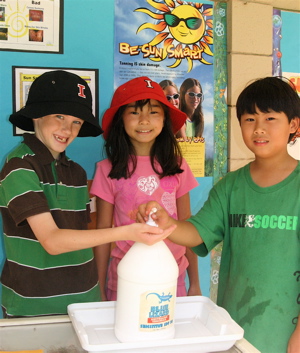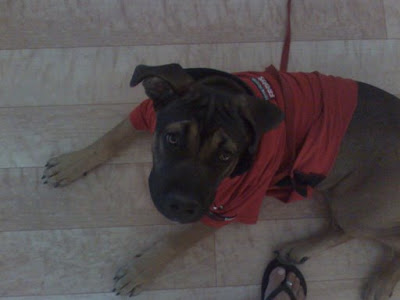Search SSA
The Importance of Educating Young Children of Sun Safety Practices
6 comments Posted by Sun Safety Alliance at 11:02 AM |
| From Sun Safety Alliance Photos |
Epidemiologic data suggest that several skin cancers can be prevented if children and adolescents are protected from UV radiation. Schools can participate in reducing exposure of young persons to UV radiation from the sun during school-related activities by offering education and skill-building activities to reinforce the development of healthful behaviors. School-based efforts to prevent skin cancer can be more effective in the framework of a coordinated school health program that includes family and community participation and builds on the context and current practices in the school and community. Coordinated school health programs aim to create and support environments where young persons can gain the knowledge, attitudes, and skills required to make and maintain healthy choices and habits. These programs integrate health education, a healthy school environment, physical education, nutrition services, health services, mental health and counseling services, health promotion programs for faculty and staff, and efforts to integrate school activities with family and community life.
 |
| From Sun Safety Alliance Photos |
Being aware of existing practices for sun exposure and sun protection among teachers, staff, and students might help define gaps in optimal sun-safety practices. Careful observations for a few days might also provide important information concerning students' use of shade areas and sunscreen at recess or lunch time, and staff's use of hats, shirts, and sunglasses. Discussions with students and staff who practice sun-safe behaviors might prove useful in planning and improving implementation of sun-safety practices.
 |
| From Sun Safety Alliance Photos |
Skin cancer prevention measures vary in both their ease of adoption and relevance. Schools should not allow an "all or nothing" approach to undermine the effectiveness of their skin cancer prevention efforts. For sun-safety protection, a short-sleeve shirt and cap might be better than no hat and a sleeveless top. Being flexible is important while moving in the direction of optimal skin cancer prevention environments, policies, and programs.
 |
| From Sun Safety Alliance Photos |
Labels: children, education, sun safety
Susan Lucy: "Basal Cell Carcinoma Affects Approximately One Million Americans Each Year"
168 comments Posted by Sun Safety Alliance at 7:33 AM Susan Lucy, is a beach body coach. She loves to work out, eat healthy, and stay fit. Susan is a mom. She is a blogger, a tweeter...
Susan Lucy, is a beach body coach. She loves to work out, eat healthy, and stay fit. Susan is a mom. She is a blogger, a tweeter...
Susan has skin cancer.
Read her story about being diagnosed with basal cell carcinoma.
Sun - Friend or Foe???
by Susan Lucy
Now, I don't have the really bad kind - melonoma. I have Basal cell carcinoma (BCC), which is the most common form of skin cancer, affecting approximately one million Americans each year. In fact, it is the most common of all cancers. More than one out of every three new cancers are skin cancers, and the vast majority are basal cell carcinomas. These cancers arise in the basal cells, which line the deepest layer of the epidermis (top skin layer).
 |
| From Sun Safety Alliance Photos |
I am very good about going to the Dermatologist. My grandfather did die of Melonoma at 50 and I have a lot of moles and freckles. So once a year, I subject myself to a full body scan by my Dermatologist. I have had a few mysterious looking moles taken off but all in all, I get a clean bill of health and the "wear suncreen and I will see you next spring" speech. This time though, I had two red patches on my right shoulder and back that I had noticed over the winter and thought they were most likely eczema. When my dermatologist told me that she didn't like the look of them and wanted to biopsy, I knew they were probably cancer or at least pre-cancerous. When I called the office for results and they told me that the doctor would call me back, I really knew. That is never a good sign.
Anyone with a history of sun exposure can develop basal cell carcinoma. However, people who are at highest risk have fair skin, blond or red hair, and blue, green, or grey eyes. Those most often affected are older people, but as the number of new cases has increased sharply each year in the last few decades, the average age of patients at onset has steadily decreased. The disease is rarely seen in children, but occasionally a teenager is affected. Dermatologists report that more and more people in their twenties and thirties are being treated for this skin cancer. Men with basal cell carcinoma have outnumbered women with the disease, but more women are getting basal cell carcinomas than in the past.
 |
| From Sun Safety Alliance Photos |
Basal cell carcinomas are easily treated in their early stages. Although this skin cancer seldom spreads, or metastasizes, to vital organs, it can damage surrounding tissue, sometimes causing considerable destruction and disfigurement — and some basal cell carcinomas are more aggressive than others.
I have two options for treatment:
EXCISIONAL SURGERY
After numbing the area with local anesthesia, the physician uses a scalpel to remove the entire growth along with a surrounding border of normal skin as a safety margin. The skin around the surgical site is then closed with a number of stitches, and the excised tissue is sent to the laboratory for microscopic examination to verify that all the malignant cells have been removed. The effectiveness of the technique produces cure rates around 90 percent.
 |
| From Sun Safety Alliance Photos |
CURETTAGE AND ELECTRODESICCATION
Using local anesthesia, the physician scrapes off the cancerous growth with a curette (a sharp, ring-shaped instrument). The heat produced by an electrocautery needle destroys residual tumor and controls bleeding. This technique may be repeated twice or more to ensure that all cancer cells are eliminated. It can produce cure rates approaching those of surgical excision, but may not be as useful for aggressive basal cell carcinomas or those in high-risk or difficult sites.
 |
| From Sun Safety Alliance Photos |
Because my cancer is superficial, I am planning on the latter option because the recovery is quicker and I won't need stitches. I still will have two circular scars as opposed to a linear one but I can deal with that. This cancer developed in the last year. Had I not had yearly checkups, I may not have had this option.
People who have had one basal cell carcinoma are at risk for developing others over the years, either in the same area or elsewhere on the body. For the next year, I will have to go back every 3 months to make sure more cancer does not develop in other areas.
I didn't post this note for pity but rather to hopefully educate people about the importance of having yearly skin checks with a dermatologist.
I am also using this as a learning lesson for my kids who give me grief all the time about wearing sunscreen. The damage on me was done years ago. 85% of sun damage is done by the time you are 18 years old. I have taken pictures of my shoulder and back biopsy sites and have talked extensively to them about wearing sunscreen. They have never had a sunburn but as they get older, they are more resistant to my insistence that they apply it every time they go out in the sun. We have a house on Cape Cod so it is virtually impossible for us to stay out of the sun. Hopefully, they will learn from my experience.
 |
| From Sun Safety Alliance Photos |
Be well,
Susan
 |
| From Sun Safety Alliance Photos |
Labels: basal cell carcinoma, skin cancer, sun safety, sunscreen, Survivors, Susan Lucy
NBC's chief medical editor, Dr. Nancy Snyderman, shares important facts about the most serious form of skin cancer, melanoma
0 comments Posted by Sun Safety Alliance at 2:12 AMVisit msnbc.com for Breaking News, World News, and News about the Economy
Labels: Dr. Nancy Snyderman, melanoma, msnbc
Lisa Carey Shares Sun Safety Tips For Man's Best Friend
0 comments Posted by Sun Safety Alliance at 1:37 AMLisa Carey, an award winning freelance writer, has worked with families volunteering and professionally for 20+ years. She shares with her readers a variety of topics important to families. E-mail Lisa with your questions about families and Houston. She recently wrote the following article for the Los Angeles eXaminer.
 |
| From RIP |
Pets are people too, well in many families they are. During the hot summer months it is important to not only provide sun safety for your people family but pets too. Pets too can become victims of heat stroke and heat exhaustion. In Heat related illnesses we talked about keeping your family safe, now learn how to keep your pet safe from the sun.
Tips for keeping your dog safe in the sun
Never leave your pet in the car. On July 2, 2009, two police dogs died after being left in police cruisers during Britain’s heat wave.
Watch the amount of time you leave your dog outside. If you dog must remain outside or is a pet that lives outside make sure you do the following:
- have water available at all times using a container that cannot be tipped over.
 |
| From RIP |
- start with ice chips so they don’t gorge on water they also enjoy the “treat.”
| From RIP |
- provide your pet with a shaded area to rest and stay safe from the sun.
| From RIP |
- if possible allow your pet to play in the sprinkler or swimming pool.
| From RIP |
- if using a crate make sure it is wire so it is open to the breeze.
| From RIP |
- if using a chain make sure they can’t tie or twist themselves up around the post or tree which eventually keeps them away from the shade and water they so badly need.
 |
| From RIP |
- when traveling, walking or visiting with your pet outdoors bring along a water spray bottle and spray his foot pads, stomach and back for relief.
| From RIP |
Have your dog shaved or groomed to have shorter hair during the summer months when “hot spots” are more likely to occur. Hot spots or open, oozing sores on your dogs skin that can occur as a result of matted or heavy hair and moisture build up. The dog will scratch and nibble at it to get relief actually making the sores much worse.
Some animals, just like people are more susceptible to the heat such as those with short noses, darker coats, thicker coats, puppies and older pets. Be aware of their special needs and circumstances.
Symptoms of heat stroke and heat exhaustion in pets include:
- panting more than normal
- blue or white tongue and bright red gums
- staggering around
- weak
- vomiting or diarrhea
- non responsive
Heat stroke and heat exhaustion is just as deadly in pets as it can be in humans. If you dog is exhibiting any of these symptoms or a combination of them get to the veterinarian immediately. Cool the dog with the use of immersion in tepid water or hose him off, gently. Take your pet into air conditioning, wet this tongue and place cool, wet towels around him until you can get professional treatment. Cooling too fast can be a problem, so be sure not to use cold or ice water. Just like with your family, your family pet’s first line of defense against sun damage and heat related illness is prevention and care.
 |
| From RIP |
This post is dedicated to "B", the rottweiler bullmsatiff of Covina, California. January 2008 - June 2009. May you RIP.
Labels: animals, lisa carey, pets, sun safety, tips

From Sun Safety Alliance Photos
Midas Touch: Before bronzing or self-tanning, always smooth skin by exfoliating and shaving legs -- even if you're a blonde. Peach-colored fuzz? No thanks.
Overexposure: 90 percent of wrinkles are caused by the sun.
 |
| From Sun Safety Alliance Photos |
Rays of Our Lives: Two-thirds of all sun damage is incidental (e.g., while driving or walking your dog, not lying by the pool).
Bright Idea: Before you choose to lunch alfresco, consider that at midday, sun rays are 10 percent UVB (the burning rays) and 90 percent UVA (the aging rays). Both contribute to melanoma, the deadliest form of skin cancer.
Skinny-Dipping: Slim and lengthen the look of legs by applying bronzer or tinted self-tanner along the outer sides of legs and thighs (from the hips down) and blending inward.
Be Firm: Ever notice how you feel less jiggly when your muscles are sore? Exercise fatigue temporarily firms up muscles, so schedule workouts and bikini days accordingly.
Hello, Sunshine: Baking and (heaven forbid) burning belong in the kitchen, not at the beach. But even if you crave a sun-kissed complexion, sun-parched skin (a.k.a. wrinkles, sagging, and brown spots) is completely unnecessary. A bevy of new bronzers and self-tanners ensure the look without the damage.
 |
| From Sun Safety Alliance Photos |
Going to be in ray range? Keep your protection potent by stocking up at the start of the season. (If you're using the right amount, you should finish a 4-ounce bottle with four applications.) Sunscreens have an expiration date -- typically a year, says Miami dermatologist Dr. Fredric Brandt. But if your bottle has been sitting out in the sun or heating up in the car, toss it. Ironically, some sunscreen ingredients lose their efficacy when exposed to heat.
Regardless of what the bottle claims, no formula is truly waterproof, warns Los Angeles dermatologist Dr. Ronald Moy. While water- or sweat-proof formulas last longer, "sunscreens do wash off with water -- whether you're sweating or swimming," says Moy. To stay protected post-pool, reapply every two hours or after toweling off.
Bare Necessities
 |
| From Sun Safety Alliance Photos |
Sexy summer skin starts with cellulite smoothing. While many dermatologists agree that topical treatments are unlikely to produce permanent results, massaging in a caffeine-infused cream can temporarily boost circulation and plump skin to make cellulite less visible. Regular exfoliation and moisturizing also help improve skin texture to minimize lumps and bumps.
As for removing unwanted hair, new regrowth-inhibiting creams and at-home bikini groomers buy you more time between waxing, depilation, or shaving. Lasers offer a permanent option but should be avoided even if you have the slightest tan. "Lasers target pigment, and since tan is pigment, it's a potential competition for the laser and could cause problems, like burning," says NYC dermatologist Dr. Bradford Katchen. If you're planning on going out in the sun, he suggests de-fuzzing at least a day before hitting the beach, especially if you use a depilatory or wax. "Both can make skin sensitive, and sun exposure will increase the irritation," he says. Yet another reason to spend some quality time under your big beach umbrella.
Reprinted with Permission of Hearst Communications, Inc. Originally Published: Summer Skin Care Guide
Labels: skin care
Interview with Sonja Gfeller, creator of AYANA Apparel, Fashion Forward, UV Protective Clothing
4 comments Posted by Sun Safety Alliance at 11:53 PM
From Sun Safety Alliance Photos
1. Describe your where you grew up.
I grew up in Aarberg, Switzerland close to the Swiss French boarder in a small historic town. My parents owned a business. The house we grew up in had a big backyard with a vegetable garden. I am the oldest of three, most close to my sister. My mother began making clothing for us children and grew to be professional tailor, creating custom clothing for her clients. Our family speaks Swiss then learned German and French in the first and second grade. English is my fourth language!
2. Where did you meet your husband?
We grew up in the same town, followed each other around since Kindergarten. My husband’s parents owned a local fashion retail store. We both eventually graduated from our own colleges and met again per coincidence in London, where we studied. We hosted a couple of parties together. No dating yet… no interest… yet! A few years later, a trade show in Zurich Switzerland united us once again. It was there, that we fell in love and have been together, (twenty years), ever since.
3. Why the name AYANA?
The name AYANA was inspired by the "Amaranth" flower, a bloom in Greek mythology that never fades. Reflecting this longevity, AYANA's high quality fashionable UV-Protective apparel personifies the everlasting femininity, beauty and style of today's modern woman. I wanted a short, skin related name, (longevity or never fading), that was easy to pronounce in any language… we also have the advantage of always being listed first since it starts with an “A”!
4. Why sun safe clothing?
When we moved to California six years ago, Frank and I loved the sunny climate. But soon I discovered that my skin was changing. It developed age spots, wrinkles, and a loss of firmness. I have always lived a healthy lifestyle, and since my skin is the most important organ, I like to treat it as my most expensive garment. I learned that it is from permanent exposure to the UV-Rays, even on a simple drive out to Los Angeles. My first reaction was to increase the amount of sunscreen I applied daily. Then I began my search for a simpler alternative. I discovered UV-protective clothing, yet was disappointed in its lack of style. So while visiting Australia, I began business research on UV protective clothing because of the country’s fantastic conceptual vision of sun safety… It was after that trip that I was ready to start my venture!
 |
| From Sun Safety Alliance Photos |
5. How did AYANA team up with the Sun Safety Alliance?
I was looking to team up with a skin cancer awareness organization and contacted the Sun Safety Alliance. After a few great brainstorming sessions, we decided to begin our collaboration.
6. What’s your inspiration for the SSA line’s logo?
We wanted to create a logo that works for men and women; that’s fun and encourages becoming aware of the sun without being afraid of it. I worked with our graphic designer and created a combination of the sun and a cancer cell, that’s right a cancer cell! We all have them in our “system”.
7. What is your vision for AYANA Apparel in the near future
To offer sustainable, fashionable clothing for everyday wear with sun protection for women and children
Labels: #SSA2009, Aarberg, ayana, sonja gfeller, sun protective clothing
This is a study by the National Institutes of Health and AVAX Technologies to determine whether M-Vax is effective in shrinking melanomas that have spread (stage IV). To increase it effectiveness, the M-Vax dosing will be followed by administration of low doses of interleukin-2 (IL2), a marketed drug that is known to stimulate immunity and cause some shrinkage of melanomas. This national study is currently recruiting patients who have Stage IV melanoma and who meet the study's other criteria.
M-Vax + Low Dose Interleukin-2 Versus Placebo Vaccine in Metastatic Melanoma in Patients With Stage IV Melanoma
Purpose
Previous studies suggests that M-Vax, a melanoma vaccine prepared from patients own cancer cells, can stimulated patients' immune system to react against their cancer. AVAX has identified a dose and schedule of administration of M-Vax that work optimally. In this study, AVAX will determine whether M-Vax is effective in shrinkage of melanomas that have spread (stage IV). To increase it effectiveness, M-Vax administration will be followed by administration of low doses of interleukin-2 (IL2), a marketed drug that is known to stimulate immunity and cause some shrinkage of melanomas.
Two-thirds of patients will receive M-Vax + IL2, and one-third will receive a placebo vaccine + IL2. The study is blinded so that neither the patients nor their physicians know which material they are receiving.
To be eligible for this study, patients must have at least one melanoma tumor that can be surgically removed and made into a vaccine. In addition, they must have melanoma that has spread to to the lungs or to soft tissue sites (under the skin, on the surface of the skin, lymph nodes). Eligible patients may have previously received one treatment (for example, chemotherapy) for their melanoma.
Side effects of M-Vax are expected to be mild; the most common is the development of sore pimples at the site of vaccine injections. The low dose IL2 may cause some fatigue and other mild symptoms.
It is expected that 387 patients will be treated in this study.
Eligibility
| Genders Eligible for Study: | Both |
| Accepts Healthy Volunteers: | No |
Inclusion Criteria:
Stage IV metastatic melanoma of cutaneous or mucosal origin or without known primary site
- At least one metastatic mass that is surgically resectable, excluding metastases in brain, bowel, or bone
- Successful preparation of a vaccine that meets quality control release criteria
- Following surgery for vaccine preparation, subjects must have at least one measurable metastasis defined by modified RECIST criteria. Non-measurable metastases may also be present. Residual metastases (measurable or non-measurable) must be limited to skin (dermal or subcutaneous), lymph node, or lung, or a combination of these.
- No prior systemic treatment or one prior systemic treatment for metastatic melanoma, not counting post-surgical adjuvant treatment with alpha interferon
- Minimum of one month and maximum of 4 months since the surgery
- Expected survival of at least 6 months
- Karnofsky performance status at least 80
- Signed informed consent
Exclusion Criteria:
Failure to prepare a vaccine that meets all quality control release criteria
- Uveal melanoma
- Post-surgical residual metastases in sites other than specified in 6.1
- Brain metastases, current or past (unless successfully treated at least one year prior to enrollment)
- Hepatic transaminase > 2.5 x ULN
- Total bilirubin > 2.0 mg/Dl
- Creatinine > 2.0 mg/Dl
- Hemoglobin <>
- WBC <>
- Platelet count <>
- Limited field radiotherapy, i.e., limited to recent surgical site, less than 4 weeks prior to first dose of vaccine
- Major field radiotherapy less than 6 months prior to first dose of vaccine
- Any systemic treatment for metastatic melanoma, including chemotherapy, cytokines, or investigational drugs less than 2 months prior to first dose of vaccine
- Previous administration of M-Vax
- Prior splenectomy
- Administration of systemic steroids less than 4 weeks prior to first dose of vaccine. Topical steroids are allowed during the study, provided these are not applied to vaccine injection sites. Inhaled aerosol steroids also are allowed during the study.
- Administration of immunosuppressive drugs less than 4 weeks prior to first dose of vaccine
- Administration of antitubercular drugs (e.g., isoniazid, rifampin, streptomycin) less than 4 weeks prior to first dose of vaccine
- HIV 1/2 positive by ELISA, confirmed by Western blot
- Hepatitis B surface antigen or hepatitis C antibody positive
- Other malignancy within 5 years except: curatively treated non-invasive melanoma, non-melanomatous skin cancer, carcinoma in situ of the uterine cervix, or early stage (stage A or B1) prostate cancer
- Autoimmune diseases that would interfere with an immunologic response (e.g., systemic lupus erythematosus, multiple sclerosis or ankylosing spondylitis)
- Concurrent medical condition that would preclude compliance or immunologic response to study treatment
- Concurrent serious infection, including active tuberculosis, or other serious medical condition
- Pregnancy or lactation (serum human chorionic gonadotropin [HCG] test must be negative in fertile women at screening visit)
- Known gentamicin allergy
- Anergic, defined by the inability to make a DTH to at least one of the following: candida, mumps, tetanus or trichophyton (based upon availability)
| Contact: Francois Martelet, MD | 215-241-9760 | fmartelet@avax-tech.com |
| United States, Florida | |
| Baptist Cancer Institute | Not yet recruiting |
| Jacksonville, Florida, United States, 32207 | |
| Contact: Troy Guthrie, MD 904-202-7998 Troy.Guthrie@BMCJAX.com | |
| Principal Investigator: Troy Guthrie, MD | |
| United States, Illinois | |
| University of Illinois at Chicago Cancer Center | Recruiting |
| Chicago, Illinois, United States, 60612 | |
| Contact: Cathleen Schaffer, RN 312-413-3863 CSchaffe@uic.edu | |
| Contact: Michael Warso, MD warso@uic.edu | |
| Principal Investigator: Michael A. Warso, MD | |
| Cancer Treatment Centers of American - Midwestern | Recruiting |
| Zion, Illinois, United States, 60099 | |
| Contact: Joy Jardinico, RN 847-731-4143 joy-jardinico@ctca-hope.com | |
| Contact: Stephen Ray, MD stephen.ray@ctca-hope.com | |
| Principal Investigator: Stephen Ray, MD | |
| United States, Kentucky | |
| University of Louisville School of Medicine | Not yet recruiting |
| Louisville, Kentucky, United States, 40202 | |
| Contact: Deborah Hulsewede, CCRC, CCRP 502-629-3308 deborah.hulsewede@nortonhealthcare.org | |
| Principal Investigator: Kelly McMasters, MD | |
| University of Kentucky - Markey Cancer Center | Recruiting |
| Lexington, Kentucky, United States, 40536 | |
| Contact: Heather Dunn 859-257-4464 hldunn2@email.uky.edu | |
| Principal Investigator: John J Rinehart, MD | |
| United States, New Hampshire | |
| Dartmouth-Hitchcock Cancer Center | Recruiting |
| Lebanon, New Hampshire, United States, 03756 | |
| Contact: Dorie Belloni 603-653-3567 Dorothy.R.Belloni@Dartmouth.EDU | |
| Principal Investigator: Marc Ernstoff, MD | |
| United States, Oklahoma | |
| Cancer Treatment Centers of America - SouthWestern | Not yet recruiting |
| Tulsa, Oklahoma, United States, 74133 | |
| Contact: Michele M Sumner, BS 918-286-5450 Michele.Sumner@ctca-hope.com | |
| Contact: Pierre J Greef, MD 918-286-5450 | |
| Principal Investigator: Pierre J. Greef, MD | |
| United States, Pennsylvania | |
| Thomas Jefferson University | Not yet recruiting |
| Philadelphia, Pennsylvania, United States, 19107 | |
| Contact: Takami Sato, MD 215-955-1752 t_sato@mail.jci.tju.edu | |
| Principal Investigator: Takami Sato, MD | |
| St. Lukes Cancer Center | Recruiting |
| Bethlehem, Pennsylvania, United States, 18015 | |
| Contact: Kelly Filchner, MSN 610-954-3582 FilchnK@slhn.org | |
| Principal Investigator: Sanjiv Agarwala, MD | |
| University of Pennsylvania Cancer Center | Recruiting |
| Philadelphia, Pennsylvania, United States, 19104 | |
| Contact: Mary Carberry 215-614-1813 mary.carberryi@uphs.upenn.edu | |
| Principal Investigator: Lynn M Schuchter, MD | |
| United States, Texas | |
| MD Anderson Cancer Center | Recruiting |
| Houston, Texas, United States, 77030 | |
| Contact: Peggy Tong, RN 713-745-5030 PLTong@MDAnderson.org | |
| Principal Investigator: Jeffrey Lee, MD | |
| Belgium | |
| Universite Catholique de Louvain (UCL) | Recruiting |
| Brussels, Belgium, 1200 | |
| Contact: Aline Duquenne 32 2 764 5427 Aline.Duquenne@uclouvain.be | |
| Principal Investigator: Jean-Francois Baurain, MD | |
| Centre Hospitalier Regional de Namur | Recruiting |
| Namur, Belgium, 5000 | |
| Contact: Jean-Phillippe Hermanne, MD 32 81 72 60 30 Hermanne@ideone.BE | |
| Principal Investigator: Jean-Phillippe Hermanne, MD | |
| Study Director: | Francois Martelet, MD | AVAX Technologies |
Labels: AVAX, Clinical Trial, M-Vax, melanoma, Survivors
